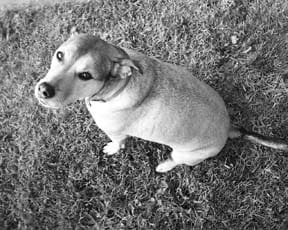by C.C. Holland
Does your dog waddle when he walks? When he lies around the house, does he cover more floor space than your area rug? Does he have four legs – and two chins?

If so, you may have an obese dog. But despite the inclination to view fat dogs as happy or jolly, it’s no laughing matter.
Recent studies indicate that up to 40 percent of dogs in the United States may be obese. The risks associated with canine obesity include musculoskeletal disorders such as osteoarthritis, compromised immune function, problems during surgical procedures, delayed wound healing, skin infections, and diabetes.
For these reasons, it’s a good idea to get Fido back into shape. Improved health, quality of life, and longevity are some of the benefits of keeping your canine companion trim. Last year, the Purina Pet Institute completed a 14-year study that found that dogs who consumed 25 percent fewer calories than their litter-mates during their lifetimes maintained a lean or “ideal” body condition and lived longer – nearly two years longer, on average.
First: Is your dog fat?
Charts and tables might give you a general idea of your dog’s recommended weight range, but due to the variations found between male and female dogs and even within breeds, it’s not an exact science. If you have a mixed-breed dog, weight charts may be of no help.
Instead, most veterinarians and nutritionists advocate using a hands-on approach to assessing body condition (see sidebar). A healthy dog will have a waist when viewed from above, have a tucked stomach when viewed from the side, and will have ribs that are easily felt through a very thin layer of flesh. If any of these hallmarks are absent, your dog may be slightly overweight. If all are missing, and if you notice fleshy deposits over the chest, spine, and base of the tail, your dog is obese.
Causes of obesity
As with humans, there are many factors that cause or contribute to weight gain. A variety of medical conditions can predispose your pet to excess weight. For example, hip dysplasia, osteoarthritis, or ligament injuries can limit your dog’s activity and contribute to weight gain. Metabolic diseases such as diabetes or hypothyroidism can also cause obesity. The first step in treating any overweight dog should be a trip to the veterinarian, to rule out these possible disease-related causes.
Some breeds are predisposed to pack on the pounds. Among these are Labrador Retrievers, Beagles, Basset Hounds, Dachshunds, Cocker Spaniels, Cairn Terriers, Cavalier King Charles Spaniels, and Shetland Sheepdogs. If you own one of these dogs, you will probably need to be more vigilant than the average owner to make sure your dog doesn’t put on extra weight.
In addition, when an animal is spayed or neutered, its energy needs decrease by about 25 percent, according to information provided by Ohio State University’s College of Veterinary Medicine. Many people believe that altered pets “automatically” become overweight. The truth is, the dog’s food ration should be decreased following neuter or spay surgery, as his or her body adjusts to lower hormone levels.
Age can also add weight. As body metabolism slows and older dogs are less active, lean body mass can decline and extra fat can creep in.
But by far the biggest reason dogs get fat is the same that humans do: they simply take in more calories than they burn. And for that, you can blame yourself.
“We are facing an epidemic of canine obesity,” said Dr. Nancy Peters, a veterinarian in private practice in Apex, North Carolina, who participated in a recent weight-management study by Purina Pet Products and North Carolina State University College of Veterinary Medicine. “And it is largely due to consistent owner behaviors, not the dog’s. We mean well, but we may not be doing what’s best for our pets.”
Feeding over-large portions and not providing enough exercise are the biggest culprits. But dogs who “scrounge” for extra food – the cat’s food, cat poop, dead things in the yard, stuff from the garbage, or compost heaps – can maintain bulk even when their “official” rations keep decreasing.
Also, dogs are quick to learn behaviors that reward them with tasty treats – and we’re not talking about the types of behaviors that the person tries to teach the dog; we’re talking about the behaviors the dog learns to “trick” the person into feeding him. Many people seem unable to resist large, pleading eyes watching them eat, and slip the dog morsels from their plates. Some dogs learn to pose and beg in front of the dog-cookie jar, causing their owners to say, “Aw! So cute!” and hand over a biscuit.
But while the equation of too many calories + too little exercise = overweight dogs seems simple, it can be anything but. Tony Buffington, DVM, dipl. ACVN, is a professor of clinical sciences at Ohio State University College of Veterinary Medicine, where he and his colleagues have developed an obesity therapy program for cats and dogs. He says weight management sounds like an easy issue, but plenty of other factors complicate things. For one: stress.
“There’s some evidence to support the link between stress and eating,” he says, drawing a parallel to how some humans respond to stress by chowing down. Also, a sense of power plays a part: “I think that animals’ perceptions of control of their environment also modulate their energy balance. We don’t have any idea to what extent we manipulate those perceptions and how that affects weight loss.”
In some cases, owners get some psychological benefits from poor feeding habits. For example, the owner who constantly spoils her dog with treats may enjoy a sense of bonding and closeness with her pet that she fears would be lost with a stricter feeding regimen.
On the other side of the coin, owner inattention can also result in a portly pooch. The owner who doesn’t have the time or the inclination to measure food might simply dump it into a bowl and refill it whenever it’s empty. If the same owner doesn’t pay much attention to exercise or interacting with the dog, the pet may simply eat too much out of boredom.
Trimming the fat
The good news: The dangers posed by obesity can be removed simply by shedding a few of your pup’s pounds.
“In most cases, a 20 percent weight loss will take even grossly obese animals out of the high-risk category for obesity-related diseases,” says Dr. Buffington.
To start your dog back on the road to slimness, start by aiming for a 10 percent weight loss – or a rate of about 1 percent of his body weight per week. A slow approach is recommended both because it allows for a more gradual change in feeding, and because studies show that rapid weight loss can increase a loss of lean body mass, which in turn can contribute to weight regain. (Lean body mass, which includes organs, are the primary drivers of basal metabolism and burn energy at far higher levels than fat mass does. Reducing the amount of lean tissue can create diminished energy requirements, so a dog can regain weight even if he’s eating less.) In other words, forget the idea of crash diets for your dog; slow and steady wins this race.
The first step: weigh your dog. Next, calculate how much your dog actually eats. Begin by listing all the food your dog gets every day, including treats and table scraps, and add up the total calorie count. Some commercial foods carry calorie information on the label; for others, you may need to take the initiative and contact the manufacturer for more details.
Make sure you take portion size into account. If the recommended ration of your kibble is two standard cups a day, but if you’re using a 16-ounce Big Gulp container to measure out the food, you’re actually feeding your dog twice the allowance – and twice the calories.
To calculate calories in non-packaged foods, such as peanut butter, table scraps, and so forth, Dr. Buffington recommends visiting the USDA’s National Nutrient Database for Standard Reference (see www.nal.usda.gov/fnic/foodcomp/Data/SR16/sr16.html), or using one of the various food-value books on the market today. An excellent reference is Bowes and Church’s Food Values of Portions Commonly Used, by Jean Pennington, et al. (At $50, this is a costly book, but useful for researching dietary concerns for your whole family. A paperback version is due out in early 2004.)
Once you have arrived at the total calories ingested by your dog, it’s time to calculate how much weight your dog should be losing – and how many calories to subtract from his diet. Again, if your dog is overweight, you should aim for a 10 percent weight loss overall, at a rate of about 1 percent per week.
If you’re inclined to pull out your calculators, here’s how the math works: If you have a 100-pound dog, a 1-percent weight loss would be 1 pound per week. One pound is equal to 3,500 calories. Thus, you’ll need to reduce his food intake by 3,500 calories per week, or about 500 calories per day.
For a 50-pound dog, the goal is to lose ½ pound per week, which means trimming weekly 1,750 calories (or 250 calories per day).
Or, there’s an easier method. Dr. Buffington uses a general rule of thumb: “Multiply your dog’s current weight by 5, and subtract that number from its current (daily) calorie intake.” In the example above, then, the 100-pound dog should have 5 x 100 calories, or 500, subtracted from his daily diet – the same figure you arrive at by doing the complicated math.
Make dietary changes
You can begin feeding at the new levels either by reducing the total amount of food you give your dog or by changing his diet. For example, you can replace high-calorie snacks with lighter fare (such as carrots, apple slices, or broccoli); reduce or eliminate table scraps; feed mini-meals throughout the day rather than two main meals (this can help reduce begging); or switch to a lower-calorie food formulated for weight loss.
Switching your dog to diet food is not a requirement, says Dr. Buffington: “Most people could feed less of the same food and they’d be fine,” he says. But he warns that cutting back too far can lead to problems. “In some animals, you’ll get to the point with the amount you’re feeding so little that they actually become at risk for nutrient depletion, especially in older or sedentary animals. So cutting back too much can be risky,” he says.
If you’re concerned about this, talk to your veterinarian. In cases like these, Dr. Buffington says, owners might be told to feed a puppy formulation, which is more nutrient-dense. And if you prepare your dog’s meals yourself, Dr. Buffington strongly encourages consulting a nutritionist and including a vitamin/mineral supplement.
If you do decide to try a commercial, low-calorie canine diet, you’ll notice that some tout their low-fat formulations; others trumpet high-protein, high-fat, low-carbohydrate combinations. Dr. Buffington says the last thing you need to worry about is whether your pet should be on the South Beach diet or the Atkins plan.
“It’s completely irrelevant to the health aspects of obesity therapy,” he says. “The relative percentages of carbohydrates to fats to proteins in diet are pretty meaningless.”
Pay attention to how much weight your dog is losing. If the weight loss is greater than two percent in a week, you may be cutting back too drastically; if it’s less than one percent, you may need to trim back further. Slow is the name of the game – remember, your pet didn’t add all the weight overnight, so don’t look for a quick fix.
Add in exercise
Exercise can be an important adjunct to nutrition in promoting weight loss. Which one plays a more important role in the slim-down program depends in part on the owner, says Dr. Buffington.
“The most important thing is what the client wants to do the most, because that’s what they’re most likely to do,” he says. “If you want your dog to lose weight, the animal needs to have a negative calorie balance of 5 calories per pound of body weight per day. You can either take 5 calories out of his bowl, exercise 5 calories out of him, or any combination of the two.”
If your dog was only slightly overweight to begin with, you can increase your dog’s exercise from the get-go. Add in a short walk each day. If he’s young and not prone to joint problems, increase the intensity of his exercise as he loses weight, by playing fetch in a hilly area. Feed your dog part of his rations in Kongs or other stuffable toys, so he has to expend energy while eating.
If your dog is quite obese, exercise should be introduced gradually. Too much activity can be dangerous to a very fat dog. Ohio State’s obesity-therapy guidelines suggest setting a goal to increase the pet’s activity by 1 minute a day until a goal of 10 minutes a day is reached. Once that level is attained, the duration can again be slowly increased.
Work for the long-term
The goal in an obesity therapy program is not primarily to lose weight; it’s to keep weight off. That means you’ll need to keep an eye on your dog’s waistline for the rest of his life. (Ideally, weigh your dog at least once a month, rather than waiting to notice physical signs that the dog has gotten fat.)
As your dog ages and his metabolism slows, he may require fewer calories to maintain his weight. If you notice weight gain, adjust his food accordingly, and if you’re concerned about him not getting adequate nutritional support, see your veterinarian. On the flip side, if he’s losing weight, that could signal an underlying illness. Consult your veterinarian before you increase his rations.
And don’t forget daily walks and games of fetch as part of his weight-management routine. Your aging dog may not appear as interested in exercise – but don’t let that keep you from giving it to him.
“Older animals are less spontaneously active, but they’ll participate if they’re invited to be active,” says Dr. Buffington. “Young dogs will often come to you with their leashes in their mouths. Older dog won’t necessarily do that. But if you bring the leash to an older dog, he’ll undoubtedly get up and head out the door.”
Reality check
Finally, suggests Dr. Buffington, if you think your dog is carrying a bit of an extra load, don’t panic and put him on a starvation diet.
“I’m not promoting overweight, but the truth is, the health risks of obesity in dogs and cats are lower than those in people,” says Dr. Buffington. He worries about people who get “overscientific and underemotional” about slimming their dogs. After all, food and bonding often go hand-in-hand, he says. “I would rather see an owner with a really happy dog who’s slightly overweight than one who destroys her relationship with the dog to give it six more months of life.”
-C.C. Holland, a frequent contributor to WDJ, is a freelance writer from Oakland, California.





Personal i love my dog fat because is more floppy and he is healthy…